The Woman Who Died A Lot
by Jasper Fforde
[Audiobook, Book]

view/request
This latest entry in the Thursday Next series of genre-bending literary absurdist fantasy adventure novels is immensely satisfying. Fforde doesn’t miss a chance for a farcical or pun-driven punchline; the twists and knots and mobius strips in the overlapping plot lines make perfect sense in the impossible logic of his alternate world, despite (or because of) which, they still provide surprises. Thursday has been pushed into semi-retirement but nevertheless manages to be at the center of the action, valiantly trying to save the world from Goliath Corporation (mission statement: to own everything and control everybody), the smitings of a wrathful deity, asteroid collisions, overdue library books, and genetically engineered fake versions of herself. The reader on this Recorded Books version has done a brilliant job of voicing the many characters and pacing the reading with a deadpan nonchalance.
Reviewed by Faith
Tagged: Fantasy, Fiction, Humor, Literary fiction
California Split
[DVD]
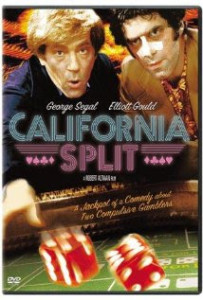
view/request
George Segal and Elliott Gould star in California Split, my all time favorite Robert Altman film and one of the best from the 1970’s. This dark, buddy comedy is centered around Bill Denny & Charlie Waters, two men who get sucked into the world of gambling. After Bill falls deep in debt to his bookie, he sells off several possessions so he and Charlie can make an all-in trek to Reno. They eventually find themselves in a tacky casino and in a dramatic, high stakes poker match.
Segal and Gould are the ultimate on screen duo with a perfect comedic volley and excellent chemistry. Additionally, this 1974 movie comes in when Altman was on top of his creative game. The director’s signature usage of wide range audio recording gives the picture an incredible depth and a real sense of place. The conversations from the extras and bit characters are always audible and usually rather interesting.
Ultimately, the story of California Split asks, does money really equal happiness?
Reviewed by Jason
Tagged: 1970s, Comedy, Drama, Feature film
Sarah’s Key
by Tatiana de Rosnay
[Book]

view/request
This emotionally laden story starts off with two alternating voices. Julia Jarmond is an American-born journalist, who has been living in Paris for 20 years, complete with a French family, and a marriage that is increasingly unstable. She is tasked with writing the story of the 1942 Vel d’Hiv Jewish roundup by the French police on the 60th anniversary of that difficult but little known episode in French history. We also see the roundup from the perspective of Sarah, a 10-year-old who is taken to the Vélodrome d’Hiver with her family, but without her younger brother. The stories of these two lives converge, with a key unlocking many long-buried secrets. This is a story that will stay with you.
Reviewed by Molly
Tagged: Fiction, France, Historical fiction, World War II
Kisses on the Bottom
by Paul McCartney
[Music CD]
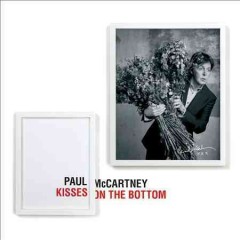
view/request
It’s been an awfully long time since Macca has been discussed on the Forbes Library staff picks blog. So, here I am to recommend a romantic offering from the melodious, ex-Beatle. Kisses on the Bottom, Paul’s tribute to the music he heard around the house as a boy, is a marvelous collection of standards with two originals tacked on for good measure. Diana Krall, Stevie Wonder, Eric Clapton, Robert Hurst, John Pizzarelli and Karriem Riggins are among the many fine musicians who make up McCartney’s backing band.
The title comes from a lyric from the opening tune, “I’m Gonna Sit Right Down and Write Myself a Letter” by Fats Waller. The introduction’s syncopated piano line, upright bass and brushes on the drum kit, set the tone for this swinging affair. Recorded at the famed Capitol Studios on Hollywood and Vine, Paul, singing with Nat King Cole’s microphone, taps into the crooning spirit of yesteryear.
Highlights include “It’s Only a Paper Moon”, “Ac-Cent-Tchu-Ate the Positive”, “My Valentine” (a Paul original), “The Inchworm”… well, I recommend ’em all!
Reviewed by Jason
Tagged: Beatles, Jazz, Standards
Midnight in Peking
by Paul French
[Book]
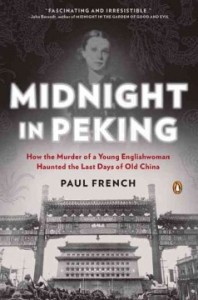
view/request
In 1937 foreigners and native Beijinger’s alike were shocked when the mutilated body of a young woman was found just outside of of Beijing’s Legation Quarter. Clearly, a terrible crime had been committed, but what had happened? The investigation was complicated by the bureaucratic system that made it difficult for law enforcement in the Legation Quarter and in Chinese Beijing to work together and the detectives in charge of the case struggled with a lack of information and communication—and what seemed all too often to be pure obstructionism from above. Paul French’s Midnight in Peking offers a fascinating glimpse of China at beginning of the Second World War, a time when powerful Europeans were leaving China, and many refugees were arriving in Beijing and nearby cities, fleeing from the USSR and Nazi Germany, and from the increasingly hostile and militaristic presence of the Japanese within China.
French’s narrative follows both the official investigations, and the unofficial investigation conducted by the victim’s father. There are some surprising twists along the way, and French takes advantage of them to keep the reader on her toes. An engaging read, but not for the squeamish or those who prefer to read stories in which justice is fulfilled.
Reviewed by Ben
Tagged: China, History, Non-fiction, True crime
How To Sharpen Pencils
by David Rees
[Book]
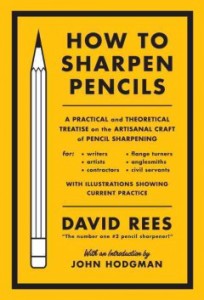
view/request
Humorist/artisanal pencil sharpener David Rees carefully guides us through the various #2 sharpening techniques and the history of the famed utilitarian instrument. The book, half manual/ half comedic piece, is both instructional and hilarious. Rees provides information on setting up a pencil sharpening workshop, pre-sharpening stretches, fancy pencil sharpening routines and of course, sharpening styles and techniques.
Note: this volume is not recommended for fans of mechanical pencils or electric sharpeners!
Reviewed by Jason
Tagged: Humor, Non-fiction, Pencils
The Professor and the Madman: a Tale of murder, insanity, and the Making of the Oxford English Dictionary
by Simon Winchester
[Book]

view/request
The creation of the Oxford English Dictionary containing 414,825 definitions was begun in 1857 and took 70 years to complete. The first edition of the OED was given to President Coolidge and is in the Calvin Coolidge Presidential Library & Museum at Forbes Library. The “Professor” is James Murray, a former schoolmaster and bank clerk, and the editor and leader of the OED project. The “madman” is Dr. W. C. Minor, a retired American Civil War surgeon who was the largest contributor with over 10,000 entries to the OED project.Minor was an extraordinary contributor but he was also a murderer, clinically insane, and incarcerated in Broadmoor, England’s asylum for criminal lunatics. Winchester tells the history of the dictionary as well as the biographies of Murray and Minor. While parts are long-winded, the story of the dictionary appeals to those who love words, books and libraries. The biography of Minor appeals to those interested in the mind, behavior and psychology. Readers who enjoy psychological fiction and are looking for a non-fiction bookmight also enjoy this.
Reviewed by Julie
Tagged: Biography, Dictionaries, Non-fiction, Psychology
F for Fake
[DVD]
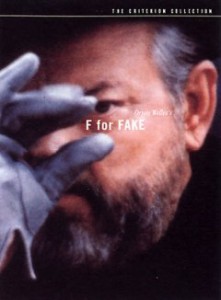
view/request
Join Orson Welles in a one of a kind cinematic experience that examines many shades of the truth. 1973’s F for Fake is presented as an essay film; most definitely the first of its kind. Welles narrates the documentary often on camera with the appearance of a worldly travel host. While delivering literary quotations in a Brechtian style, interviewing subjects and delivering personal tales in his larger than life/life of the party personality, he incorporates a wide range of footage (including bit-lits from his recently abandoned projects) and edits various film formats in dramatic fashion.
At the heart of the movie, Welles discusses the parallels between notorious art forger Elmyr de Hory and the biographer Clifford Irving. Irving who settled in Ibiza working on the de Hory tale, later went on to create a fake of his own: a false biography of Hollywood tycoon Howard Hughes. The director weaves these and other scandals and also shines the light on his infamous War of the Worlds radio broadcast.
Though the content in F for Fake is presented as fact, the masterful Welles, a fan of the slight of hand, cannot resist the urge to play with his audience.
Reviewed by Jason
Tagged: Documentary, Drama
Headquarters
by the Monkees
[Music CD]
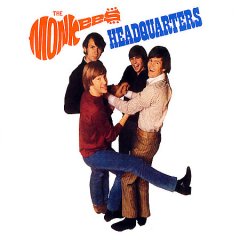
view/request
To earn the Monkees the right to play on their own records, Michael Nesmith’s fist had punch a wall accompanied with the threat “that could’ve been your face”. Thankfully the powers that be relented because Headquarters, the band’s third release, is possibly their most unified, spirited effort.
And now a bit about the personnel… Nesmith handles much of the guitar duties, the classically trained Peter Tork plays keyboards, guitars, basses and banjos, Mickey Dolenz sits behind the drum kit and dabbles on the guitar and Davy Jones shakes a mean tambourine and maraca. All four sing. Producer Chip Talyor plays the occasional bass.
Michael Nesmith, asserting himself as the band’s most prolific songwriter, contributes the twangiest of tunes including “Sunny Girlfriend” and “You Just May Be the One”. Peter Tork writes “For Pete’s Sake”, the groovy number that became the track which rolled over the end credits of the band’s television program. Davy tackles the Hildebrand/Keller number “Early Morning Blues and Green” replete with Wurlitzer electric piano and a wild, distorted organ. Mickey Dolenz sings and writes the psychedelic “Randy Scouse Git” (included on most Monkees “best of” compilations), a song that was inspired by the band’s trip to London and hanging out with the original Fab Four.
Headquarters sounds like a band working together trying to find their sound. It’s garage, it’s pop, it’s joyful.
Reviewed by Jason
Tagged: 1960s rock music, Pop music
How Music Works
by David Byrne
[Book]
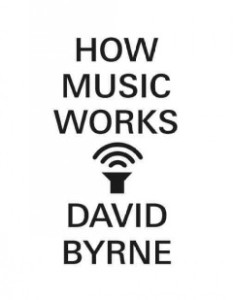
view/request
“I think I managed to give a sense that the world of music is wider than my personal experience, but my experience figures in here too”, David Byrne writes about his recent book How Music Works, and this statement gives you a very good idea of what you will find in this very enjoyable book. How Music Works explores the world of music through the experience of one musician’s experiences and wide ranging thoughts. As a result, it is neither a comprehensive book on the nature of music nor a complete biography of its author, though it combines elements of both. Byrne explores the history of music and musical thought, the influence of technology and economics on music, the role of music in society, and the future of the music industry. Along the way we learn much of Byrne’s career, his own approach to music, art, and performance in general.
Byrne is an excellent writer, and a man with wide ranging and interesting ideas. Reading How Music Works is a pleasure, and left me with an increased urge not only to explore more of his music and to read more of his writing (Forbes Library also owns his Bicylce Diaries), but most of all, to make more music of my own. It is, above all, David Byrne’s unending enthusiasm for everyday creativity and for the participation of everyday people in the world of music that will make the greatest impression on you. A great book which will be enjoyed by music lovers of all types.
Reviewed by Ben
Tagged: Music, Non-fiction, Pop music
The Eyre Affair
by Jasper Fforde
[Audiobook]

view/request
The first title in the Thursday Next series, takes us to a slightly different version of Great Britain, around 1985, where time travel is routine, and people have cloned dodo birds has pets. Thursday is a member of Special Operations 27, the literary detective division. Her father is a member of the Chronoguard, and her uncle invents all kinds of interesting devices. Thursday is involved when original manuscripts get stolen, and the story line starts changing. Jane Eyre is kidnapped and Thursday has to enter the novel to try to track down the villain before any lasting harm occurs to the storyline. A love of literature and some acquaintance with Jane Eyre suggested. Surreal and funny with wonderful characters.
Susan Duerden was an engaging reader. 10 discs, 12 hours 15 minutes
Reviewed by Molly
Tagged: Alternative history, Comedy, Fantasy, Fiction
Bobby Charles
by Bobby Charles
[Music CD]
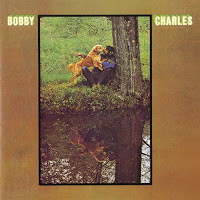
view/request
No album better represents the sound of a bunch of guys hanging out, having good times and recording music than Bobby Charles’s self-titled album. Charles, celebrated for writing “See You Later Alligator” for Bill Haley and “Walking To New Orleans” for Fats Domino, found himself relaxing with The Band in Woodstock, New York in ’71. The circumstances for his east coast residence have something to do with a divorce and hiding out from a Nashville marijuana bust.
The Band (with Dr. John in tow) back Charles through a set of lazy melodies with New Orleans influence and a loose, country bounce. With this all-star line-up, it’s really not a shocker that the backing is as cool as can be. However, it’s Charles’s voice that shines brightest. There is a exceptional fullness and soul in each word that Charles projects and yet he sometimes gives the listener the impression that he’s singing softly, almost narrating a local tale.
The feeling of living out in the country, slowing down and finding peace are intertwining themes throughout Bobby Charles. On “Small Town Talk”, after a whistled intro, Charles croons “and it’s small town talk, you know how people are/they can’t stand to see someone else doing what they want to”. “Tennessee Blues”, the album’s closer, is also no exception to this sensibility. The song is so perfect and timeless, one might imagine Charles ripped it from a book of standards at least 25 years earlier. With one of my all time favorite vocal performances (Doug Sahm’s version is definitely worth hearing as well), Charles sings:
Find me a spot on some mountain top
With lakes all around me
With valley and streams and birds in the trees
And lakes that surround me
A place I feel loose
A place I could lose these Tennessee Blues
Reviewed by Jason
Tagged: Country music, Folk music, New Orleans, Rock music, Soul music












